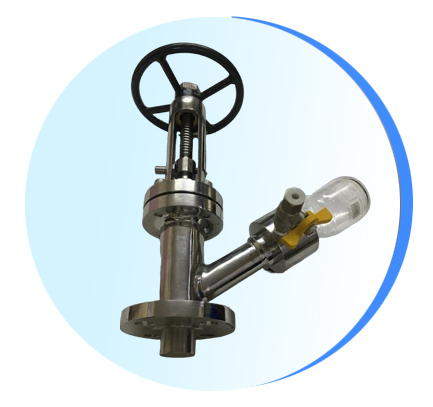
Pawar Industries is leading Manufacturers in Y Type Sampling Valves
Y type sampling valves are essential components used in industrial applications for accurate and representative fluid sampling. These valves are specifically designed to provide reliable and contamination-free sampling of fluids, ensuring process integrity and quality control. In this comprehensive guide, we will explore the working principles, advantages, applications, and maintenance considerations of Y type sampling valves. Whether you are an engineer, technician, or someone interested in fluid sampling systems, this article will provide valuable insights into the functionality and benefits of Y type sampling valves.
Working Principles of Y Type Sampling Valves -
Y type sampling valves operate based on a Y-shaped body design that allows for fluid diversion during the sampling process. These valves consist of a valve body, a sampling chamber, a handle or actuator, and inlet and outlet connections.
When the valve is actuated, the handle or actuator rotates to open the sampling chamber, diverting a portion of the fluid flow into the chamber. The fluid in the chamber represents an accurate and representative sample that can be collected for analysis or testing. After sampling, the valve is closed, redirecting the remaining fluid flow back into the main line.
Y type sampling valves offer advantages such as accurate sampling, prevention of contamination, and ease of use. They are suitable for applications that require representative fluid sampling, such as chemical processing, food and beverage, pharmaceuticals, and water treatment.
Advantages of Y Type Sampling Valves -
Y type sampling valves offer numerous advantages, making them a preferred choice in industrial applications where accurate and reliable fluid sampling is critical. Some key advantages include:
a) Accurate Sampling : Y type sampling valves provide accurate and representative fluid sampling, ensuring that the collected sample is reflective of the fluid's composition and properties. This is essential for quality control, process optimization, and compliance with regulatory standards.
b) Contamination Prevention : These valves are designed to prevent contamination during the sampling process. The Y-shaped body diverts the sample from the main flow, isolating it from potential contaminants, ensuring the integrity of the sample and minimizing the risk of cross-contamination.
c) Ease of Use : Y type sampling valves are user-friendly and easy to operate. With their simple handle or actuator mechanism, operators can easily open and close the sampling chamber, allowing for convenient and efficient sampling without the need for complex procedures or specialized equipment.
d) Versatility : Y type sampling valves can handle a wide range of fluids, pressures, temperatures, and flow rates. They are suitable for various industries, including chemical processing, food and beverage, pharmaceuticals, water treatment, and more.
e) Process Optimization : Accurate fluid sampling using Y type sampling valves enables process optimization by providing valuable data for analysis and monitoring. The collected samples can help identify process inefficiencies, detect contamination issues, and make informed decisions for process improvement.
Applications of Y Type Sampling Valves -
Y type sampling valves find applications in diverse industries where accurate and representative fluid sampling is crucial. Some common applications include:
a) Chemical Processing : Y type sampling valves are extensively used in chemical processing plants for sampling various fluids, including liquids and gases. They provide accurate sampling for quality control, process monitoring, and compliance with industry regulations.
b) Food and Beverage Industry : These valves play a vital role in the food and beverage industry for sampling liquids such as juices, beverages, or dairy products. They ensure accurate sampling for product quality testing, consistency checks, and compliance with food safety standards.
c) Pharmaceutical Industry : Y type sampling valves are employed in the pharmaceutical industry for sampling fluids, such as pharmaceutical ingredients, intermediates, or finished products. They provide accurate and representative samples for quality control, batch release, andregulatory compliance.
d) Water Treatment : Y type sampling valves are utilized in water treatment plants for sampling water streams at different stages of the treatment process. They help monitor water quality, detect contaminants, and ensure compliance with regulatory standards.
e) Oil and Gas Industry : These valves find applications in the oil and gas industry for sampling fluids, such as crude oil, natural gas, or refined products. They enable accurate sampling for quality control, product analysis, and environmental monitoring.
f) Petrochemical Industry : Y type sampling valves play a crucial role in the petrochemical industry for sampling various fluids, including chemicals, solvents, or petrochemical intermediates. They ensure accurate sampling for quality control, process optimization, and safety monitoring.
Maintenance Considerations for Y Type Sampling Valves -
Proper maintenance of Y type sampling valves is essential to ensure their optimal performance and reliable sampling results. Here are some important maintenance considerations:
a) Regular Inspection : Conduct routine inspections to check for signs of wear, corrosion, or damage to the valve body, sampling chamber, seals, and other components. Replace any worn or damaged parts promptly to maintain efficient operation and prevent leakage.
b) Cleaning and Sterilization : Properly clean and sterilize the sampling valve and associated equipment before and after each sampling event. This helps prevent cross-contamination and ensures the integrity of the samples collected.
c) Lubrication : Ensure proper lubrication of the valve stem, handle, or actuator mechanism as recommended by the manufacturer. Lubrication helps reduce friction, ensures smooth operation, and extends the valve's lifespan.
d) Calibration : Periodically calibrate the sampling valve to verify its accuracy and reliability. This can be done using traceable reference standards or through calibration services provided by qualified professionals.
e) Training and Documentation : Ensure that personnel responsible for sampling valve maintenance receive proper training on maintenance procedures, sterilization protocols, and safety precautions. Keep detailed records of maintenance activities, including inspection dates, cleaning and sterilization processes, calibration results, and replacements, to track the performance history of the valve.


